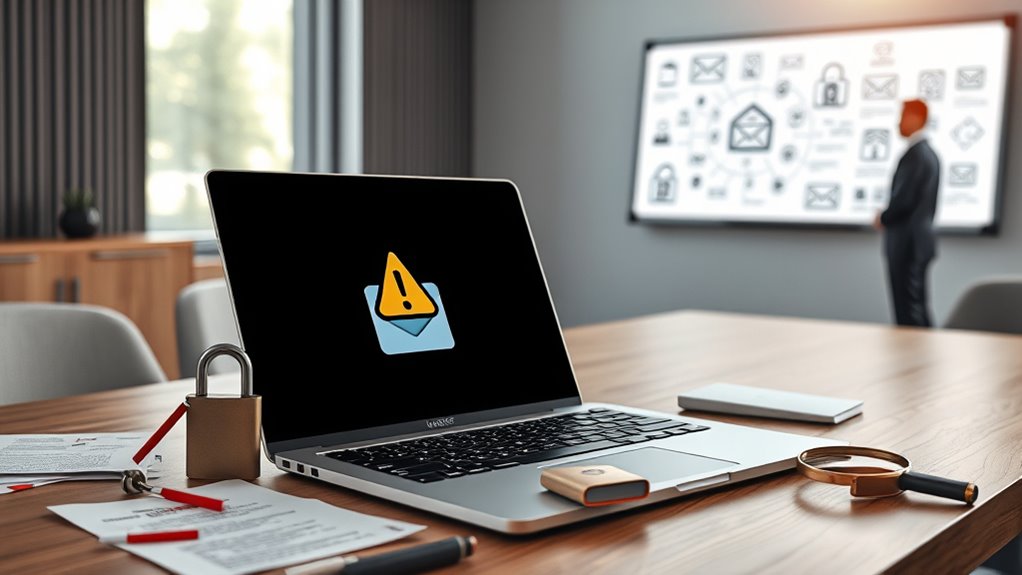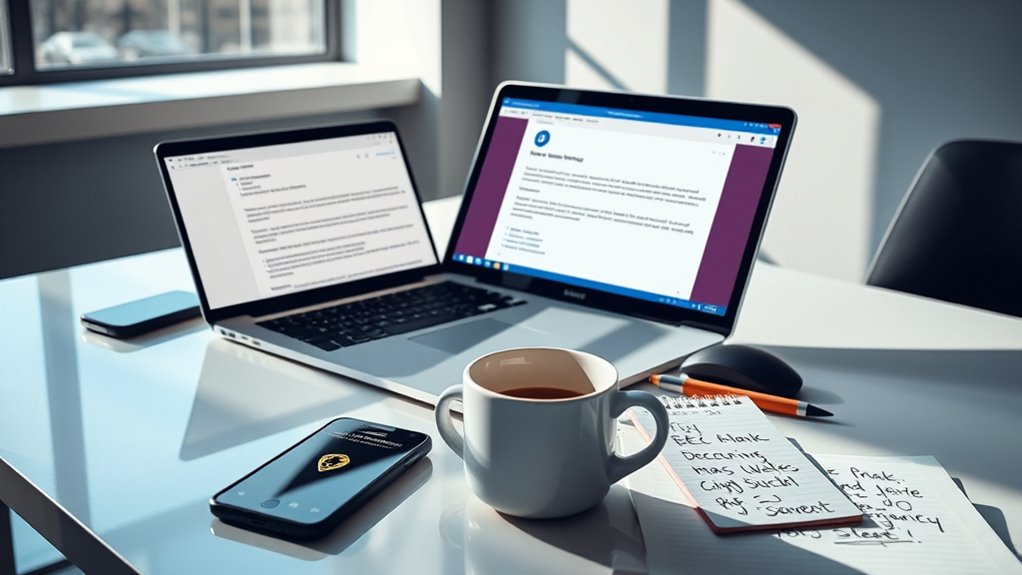To protect against Email Fraud and Business Email Compromise (BEC), always verify sender email addresses and avoid trusting display names alone. Use strong, unique passwords for each account and enable two-factor authentication for added security. Educate yourself and your team about common phishing tactics, like fake invoices and urgent requests. Keep software updated and utilize email filtering tools to catch malicious messages. Learning about advanced safety measures can profoundly bolster your defenses against these threats.
Key Takeaways
- Scrutinize sender email addresses for variations to identify potential phishing attempts and avoid falling victim to BEC.
- Confirm unexpected requests through trusted communication channels rather than replying directly to suspicious emails.
- Use strong, unique passwords for each account and enable two-factor authentication for added security against unauthorized access.
- Regularly educate employees about phishing tactics and conduct training sessions to enhance awareness and response to potential threats.
- Keep software and email clients up to date, implementing email filtering solutions to block malicious emails and reduce vulnerabilities.

How can you protect yourself from the rising threat of email fraud and Business Email Compromise (BEC)? It’s vital to adopt secure email practices that can help shield you from these growing threats. Phishing scams are becoming increasingly sophisticated, targeting individuals and businesses alike. To guard against these tactics, you need to stay informed and proactive.
First, always scrutinize the sender’s email address. Phishing scams often involve addresses that look similar to legitimate ones but contain slight variations. Instead of just glancing at the name in your inbox, take the time to examine the actual email address. If something feels off, trust your instincts and don’t engage with the email. It’s also wise to verify any unexpected requests for sensitive information by contacting the sender through a known and trusted method, rather than replying directly to the suspicious email.
Always verify the sender’s email address, as phishing scams often use deceptive variations. Trust your instincts and confirm unexpected requests through known methods.
Next, implement strong password practices. Use unique passwords for different accounts and consider using a password manager to keep track of them securely. Enable two-factor authentication (2FA) wherever possible; this extra layer of security can make a significant difference in protecting your information. Even if someone manages to get your password, 2FA can prevent unauthorized access.
Educate yourself and your team about common phishing scenarios. Many attacks involve fake invoices, tax-related emails, or urgent requests for money transfers. By recognizing these signs, you can avoid falling into the trap. Regular training sessions can ensure that everyone in your organization is prepared and aware of the tactics used by cybercriminals.
Keep your software updated. Cyber criminals often exploit vulnerabilities in outdated software. Ensure that your operating systems, email clients, and security software are up to date to protect against potential attacks. Regular updates can patch known security holes that hackers might exploit.
Finally, consider implementing email filtering solutions that can help detect and block malicious emails before they reach your inbox. These tools can provide an additional layer of defense against phishing scams and other threats, making it harder for cybercriminals to succeed. Additionally, maintaining regular inspections of your cybersecurity measures can help identify potential weaknesses before they are exploited.
Frequently Asked Questions
What Are the Signs of a Potential Email Fraud Attempt?
You can spot potential email fraud attempts by looking for several signs. First, check for phishing detection alerts from your email provider. Then, be wary of suspicious email behaviors, like unexpected requests for sensitive information or unusual sender addresses. Watch for poor grammar or urgent calls to action, as these are common tactics fraudsters use. Finally, if something feels off, trust your instincts and verify the request through another communication method.
How Can I Report Email Fraud Incidents?
To report email fraud incidents, you can start by documenting the suspicious emails, noting sender details and any links or attachments. Next, forward the email to your IT department or security team, and notify relevant authorities like the FTC or your local law enforcement. Stay vigilant and promote phishing awareness in your organization while practicing email security best practices. Your prompt action can help protect others from falling victim to similar scams.
What Legal Actions Can Victims of BEC Take?
If you’re a victim of BEC, you can pursue legal remedies through civil litigation. You should document all communications and losses, as this will strengthen your case. Consider consulting with a legal professional specializing in cybercrime or fraud, who can guide you on filing a lawsuit against the perpetrators. You might also report the incident to law enforcement, which can help in pursuing justice and potentially recovering lost funds.
Are There Specific Industries Targeted More by BEC Scams?
Yes, certain industries face higher scam prevalence due to their financial operations and sensitive data. For instance, real estate, finance, and healthcare are often targeted. You might think your industry is safe, but cybercriminals adapt quickly to industry trends, so vigilance is essential. Regular training and awareness can help you spot red flags. Don’t underestimate the threat; staying informed is key to protecting your organization from potential scams.
Can Personal Email Accounts Also Be at Risk From BEC?
Yes, personal email accounts can be at risk from BEC scams. Cybercriminals often use email phishing tactics to compromise personal accounts, tricking you into revealing sensitive information. To enhance your personal account security, always verify the sender’s identity and avoid clicking on suspicious links. Implementing two-factor authentication and regularly updating passwords can also provide an extra layer of protection against these threats. Stay vigilant to safeguard your personal information!
Conclusion
So, you think you’re too smart to fall for email fraud, huh? Ironically, that confidence might just be your Achilles’ heel. Remember, even the best of us can be duped by a cleverly crafted email. Protecting your business from BEC isn’t just a task; it’s a necessity. By staying vigilant and implementing strong security measures, you can guarantee that your email isn’t the one that opens the door to disaster. Stay sharp, because the scammers are always waiting!









